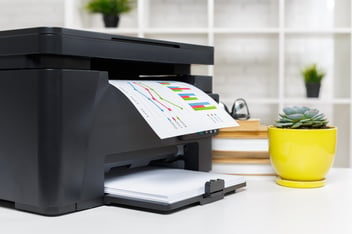Why Digitizing Your Print Workflows is Such a Good Idea
The Evolution of Processes
The myth of the paperless office was busted long ago. And rightly so – it just doesn’t make sense for any business to completely abandon the use of paper. Just look at departments like HR, finance and legal that rely heavily on paper on a day-to-day basis.

The thing is, technology is changing office workflows in fundamental ways.
Smartphones and tablets mean you can access almost any information, wherever you are. The cloud is making it easier for teams to collaborate, wherever team members are. And the Internet of Things is making it easier to automate whole workflows.
Your office may never become completely paperless – but your workflows are going to change in some pretty big ways.
The key is to identify the paper-based workflows that currently slow your people down, cost more than they should and put your sensitive data at risk.
But the opportunity is a whole lot bigger than that.
Workflow transformation is your big opportunity to change the way people work together – to cut through cross-departmental silos, to find more efficient ways to collaborate, and to make your business’ most important information easier to find and more secure. It’s also a shortcut to happier staff, and in turn, more pleasant customer experiences.
To transform your workflows is to transform your business.
In this eBook, we’ll show you all the ways paper-based workflows impact your business and what you should do about them. You’ll gain insights about how to digitize paper workflows quickly and easily, and gain visibility and control over all your document processes.

Let’s dive in.
The True Costs of Paper
Paper-based processes often play an important role. Sometimes people prefer using print outs in meetings, some regulations require businesses to keep hard copies, and sales people often prefer having the freedom to leave well-made documents behind with prospects.
But in practice, most businesses have more paper-based processes (and more paper-based steps in those processes) than they really need. And if you’re one of them, the impact of all those outdated processes could be keeping your business from reaching its full potential in three important ways.
1. They Hurt Your Bottom Line
Paper-based processes cost you directly in terms of your printers and print supplies. But uncontrolled printing will cost you a lot more.
Whether for business or personal reasons, employees abusing print will drive up your maintenance costs and supply needs. Plus, those abusing print are unlikely to be thinking about things like whether or not mono would have sufficed instead of color, which wastes even more money.
So the challenge for you is to transform your processes in ways that help you protect your bottom line from problems like uncontrolled printing. But also in ways that help you get more value from that infrastructure.
For starters, that means identifying the biggest sources of print waste. If you’ve got big stacks of printed documents near your printers, that’s a good sign there’s room for improvement (and a big security issue, but we’ll get to that in a second).
But it also helps to think about maximizing your return on investment. Your print infrastructure needs to do more than just print. It needs to help you manage the hundreds of processes across departments, and empower the people in those processes to work more digitally, too.
2. They Hurt Your People’s Productivity
Even the simplest tasks can cause productivity losses.
Put together, the productivity costs of paper-based processes are too high to ignore. So the challenge for you is to first identify the biggest sources of workflow inefficiency and waste. Then, simplify and automate those processes with smarter, more digital print infrastructure.
The good news is that once you’ve modernized, you can actually use modern print infrastructure to get data-driven insights on everything from print volumes to workflow productivity, liberating your people from making decisions based on guesswork.
3. They’re a Security Risk
For example, adding a signature to a paper document or contract takes time. And then the document needs to be returned and approved too.
A digital approach to the same process gets the same result, only it’s easier for the person signing and it moves a lot faster.
That may sound small. But the inefficiencies caused by paper-based processes can add up:
People waiting in line for a shared central printer waste as many as 13 hours every year.
Teams proofreading and making edits to printed documents need to do double work when they’re updating the digital version of the file.
When executives need to make decisions based on printed documents, it’s harder for them to review on the move. And their teams have to wait longer.
Paper-heavy processes like invoicing involve a lot of steps where files are being moved from paper to digital and back. The more frequently you invoice, the more inefficient the process.
The common perception is that all threats to your data come from hackers. But the reality is that broken internal processes and procedures put documents at risk all the time.
For example, remember that big stack of uncollected documents near your printers? Suppose a performance review, acquisition statement, disciplinary action or salary breakdown is in that pile. That’s sensitive data that could easily make its way into the wrong hands.
And the problem is that all-too-often it does – 60% of organizations reported print-related breaches in 2016.
To deal with this, you need to ensure sensitive documents can only be printed by the right people, with the right credentials, so everyone’s free to work without fear of losing critical information. More importantly, you need to ensure your print infrastructure is a central part of your security strategy, rather than an afterthought.
Read the full original content here.




